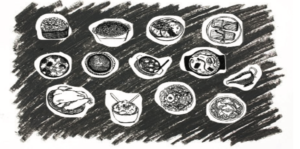As it was explained to me as a bright-eyed and bushy-tailed first year, our current mascot was voted on by the student body in the eighties from a list of possibilities.
Has there ever been a cyclone in Oakland? Nope. Mills Hall wasn’t miraculously assembled by a cyclone, no one called the students of the young women’s seminary “cyclones” for their fast paced banter and wit — nothing like that. There is nothing about a cyclone that represents Mills.
We’re not the kind of school that needs a symbol with connotations of masculinity and aggression to show our opponents on the sports field how tough we are. As a three year rower, I can promise you that when my friends and family send me off on the water with a rousing C-Y, C-Y-C cheer, I’m thinking less about the ferocity of a gale force wind and more about how much their love and support means to me.
What we are as a college is a community of thoughtful, academic women who aren’t in the world to lay waste, but to rebuild it as a better and more just society. We are, in short, less likely to need a mascot to represent us on the field than in the classroom, and in academic journals. We are increasingly diverse in terms of age, race, gender expression and sexuality. Why can’t we have a mascot that represents that?
A mascot like Phillis Wheatley, the first published African-American author. Born in Gambia, Senegal, she was sold into slavery at the age of seven or eight and transported to North America. She published her book of poetry, Poems on Various Subjects, Religious and Moral, in 1773 which earned her acclaim from luminaries such as George Washington. Wheatley was a woman who pursued education against all barriers, as Mills women do today. How awesome would it be to cheer on the soccer team with cheers of “Write ‘em out!” ? A quill breaking the chains of slavery would look awesome on t-shirts.
Or Ada Lovelace, the only legitimate child of Lord Bryon, who wrote the first computer program in 1842. She was an English noblewoman who was one of the first mathematicians to predict that computers would someday would go beyond simple number crunching. Mills was the first women’s college to offer a computer science degree, and we have a strong history of supporting women in the math and sciences. We could be the Programmers! And have an abacus, with or without lace, for
the symbol.
What about Calafia, who Fortún Ximénez named California after in 1534? She’s a mythical black warrior queen who ruled over the island of California in a Spanish novel written around 1500. Her Wikipedia page contains this golden nugget: “Calafia commanded a trained force of 500 man killing griffins.” It would be great to have a mascot that celebrates the deep connections Mills has to California, the contributions of African-American women to Mills and that involves raging griffin imagery.
Another great woman to consider is Juana Inés de la Cruz de Asuaje y Ramirez. Born a bastard in Mexico City in 1648, she was a child prodigy in mathematics, logic, Latin and the Aztec language of Nahuatl. She refused marriage and instead joined a nunnery to write poems and essays, including a feminist text making fun of men who privately frequented prostitutes and publicly condemned them.
If a historical or mythological figure has too much potential for controversy and misinterpretation, what about the Mighty Pens? The Feral Cats? I would personally really enjoy being represented at sporting events by people in cat face paint.
I take pride in being part of the Mills community. I think that despite our flaws (why are we so weird about admitting trans women to a women’s college?), Mills works hard to be a more just, affordable and inclusive school. We deserve a mascot that represents all of that, and all that we have the potential to be.
Colleen Kimsey is a senior at Mills.


